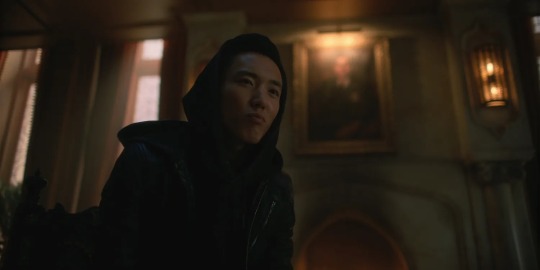#image bank klaus and ben
Explore tagged Tumblr posts
Text
I’m so sad we didn’t get a single version of Klaus & Ben in s4. ☹️


robert sheehan and justin h. min
- [the way they stole their interactions from us]
#the umbrella academy#tua s4#robert sheehan#justin h min#ben hargreeves#klaus hargreeves#tua#tua s4 fail#image bank klaus#image bank ben#image bank short hair#justin min#image bank short hair klaus#image bank s4#costume s4#costume yellow robe#image bank tua s4#costume blue hoodie
557 notes
·
View notes
Text

#klaus hargreeves#ben hargreeves#the umbrella academy#tua#robert sheehan#justin h min#mean ben hargreeves#mean ben#ded and gonne#ded & gonne#image bank klaus and ben#image bank klaus and mean ben#location hotel#location hotel obsidian#costume plaid pants#costume overcoat#costume macintosh#costume black tshirt#justin min#justin is so adorable rn i want to put him in my pocket robbie i want to put in my bed#tua s3#sparrow ben hargreeves
32 notes
·
View notes
Photo
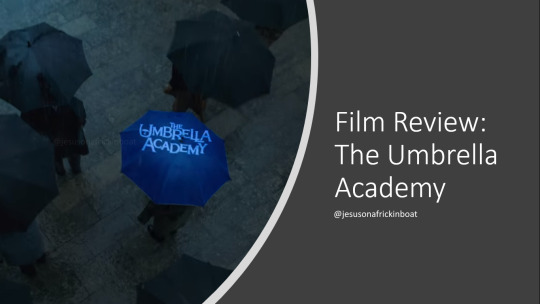
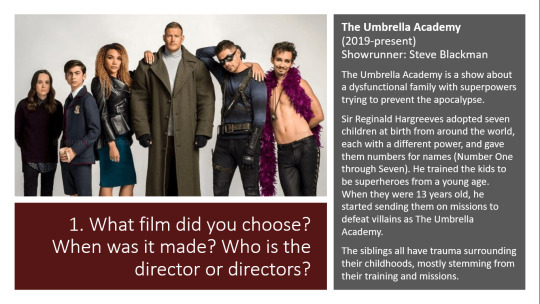

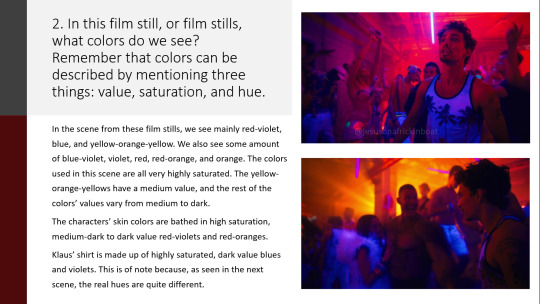


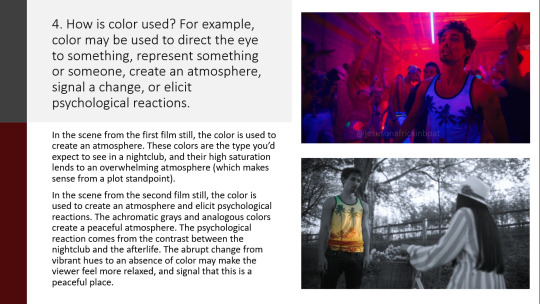
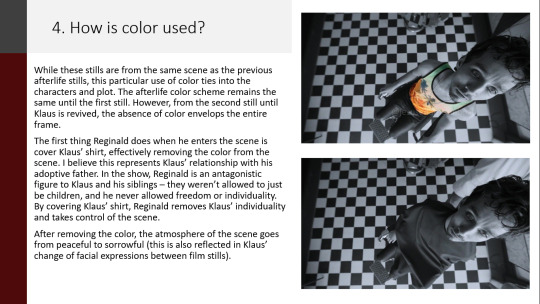

Film Review: The Umbrella Academy
Season 1, Episode 7 “The Day That Was”
One of my projects in Color Theory this semester was called Film Review. The assignment was to pick one or more stills from a movie or TV show and answer five questions about how color was used during the scene(s). I chose the Klaus-centric rave & afterlife scenes from s1 ep7. Honestly, I probably wrote a lot more than actually necessary for the assignment 😂 The black & white except-for-Klaus’-shirt afterlife scene was actually the first thing I thought of when the teacher gave us the assignment, mostly because I’ve been trying to figure it out for 3 years now. Obviously with the new revelation about color in the afterlife, I finally have what I’d call an answer (though I guess could still be labeled as a theory). But! I did this assignment back in April, so these are my observations/theories from then.
Image ID below the read more (due to length)
[Image ID: nine powerpoint slides.
Slide 1: an image of a season 1 title card that is a birds eye of people dressed in black holding black umbrellas, with one holding a blue umbrella that says “The Umbrella Academy” standing in the rain. The slide says “Film Review: The Umbrella Academy. @jesusonafrickinboat”
Slide 2: a season 1 promo image of Viktor, Five, Allison, Luther, Diego, and Klaus. The slide title reads, “1. What film did you chose? When was it made? Who is the director or directors?” The body text reads, “The Umbrella Academy (2019-present) Showrunner: Steve Blackman The Umbrella Academy is a show about a dysfunctional family with superpowers trying to prevent the apocalypse. Sir Reginald Hargreeves adopted seven children at birth from around the world, each with a different power, and gave them numbers for names (Number One through Seven). He trained the kids to be superheroes from a young age. When they were 13 years old, he started sending them on missions to defeat villains as The Umbrella Academy. The siblings all have trauma surrounding their childhoods, mostly stemming from their training and missions.”
Slide 3: a season 1 screenshot of 13 year old Luther, Diego, Allison, Klaus, Five, and Ben lined up in their uniforms after the bank heist. The slide title reads, “1. What film did you chose? When was it made? Who is the director or directors? (cont.)” The body text reads, “I specifically chose film stills from Season 1 Episode 7 ‘The Day That Was’ (2019) Episode director: Stephen Surjik The film stills I chose are from sequential scenes that follow of the siblings, Klaus (Number Four), whose powers have to do with the dead. At this point in the show, he is getting sober after a life of drugs (which dampen his powers). In short: Klaus goes to a nightclub to find one of his brothers and dies after being thrown to the ground, hitting his head on the concrete floor. He goes to the afterlife where he meets God (who doesn’t like him) and talks with his adoptive father. Klaus then comes back to life.”
Slide 4: two season 1 screenshots from the rave scene. The first shows Klaus with Ben behind him and people dancing around them. The second shows Klaus, Luther, and the girl Luther brings home from the rave with people dancing around them. The slide title reads, “2. In this film still, or film stills, what colors do we see? Remember that colors can be described by mentioning three things: value, saturation, and hue.” The body text reads, “In the scene from these film stills, we see mainly red-violet, blue, and yellow-orange-yellow. We also see some amount of blue-violet, violet, red, red-orange, and orange. The colors used in this scene are all very highly saturated. The yellow-orange-yellows have a medium value, and the rest of the colors’ values vary from medium to dark. The characters’ skin colors are bathed in high saturation, medium dark to dark value red-violets and red-oranges. Klaus’ shirt is made up of highly saturated, dark value blues and violets. This is of note because, as seen in the next scene, the real hues are quite different.”
Slide 5: two season 1 screenshots from the afterlife scene. The first shows Klaus and God, a little girl on a bike, Klaus’ shirt is the only thing that still has color. The second shows Klaus looking up at Reginald in the barbershop scene, there is no color in the entire scene. The slide title reads, “2. In this film still, or film stills, what colors do we see? Remember that colors can be described by mentioning three things: value, saturation, and hue.” The body text reads, “In the scene from the first film still, we see mostly grays that vary in value from light to dark. There are three colors present: orange, yellow, and green-blue. All three colors are highly saturated. The orange values vary from dark to medium-light. The yellow values vary from medium to very light. The green-blue values vary from dark to light. In the second half of the afterlife scene, Klaus’ shirt is covered by a black cape, removing all color from the scene. From that point until the end of the scene, there are only achromatic grays with a range of values from dark to light.”
Slide 6: two season 1 screenshots, one from the rave scene, one from the afterlife scene. The first shows Klaus with Ben behind him and people dancing around them. The second shows Klaus and God, a little girl on a bike, Klaus’ shirt is the only thing that still has color. The slide title reads, “3. What kind of palette do we see? Did the filmmaker use a known color scheme, such as monochromatic, analogous, complementary, triadic, tetradic, or split complement? Is there a noted absence of hue? Or has the filmmaker thrown in almost every hue in the rainbow?” The body text reads, “In the scene from the first still, the filmmaker didn’t use a known color scheme. We would call it a ‘Half Wheel’ palette. In the scene from the second film still, there is a noted absence of hue except for Klaus’ shirt, which uses an analogous palette.”
Slide 7: two season 1 screenshots, one from the rave scene, one from the afterlife scene. The first shows Klaus with Ben behind him and people dancing around them. The second shows Klaus and God, a little girl on a bike, Klaus’ shirt is the only thing that still has color. The slide title reads, “4. How is color used? For example, color may be used to direct the eye to something, represent something or someone, create an atmosphere, signal a change, or elicit psychological reactions.” The body text reads, “In the scene from the first film still, the color is used to create an atmosphere. These colors are the type you’d expect to see in a nightclub, and their high saturation lends to an overwhelming atmosphere (which makes sense from a plot standpoint). In the scene from the second film still, the color is used to create an atmosphere and elicit psychological reactions. The achromatic grays and analogous colors create a peaceful atmosphere. The psychological reaction comes from the contrast between the nightclub and the afterlife. The abrupt change from vibrant hues to an absence of color may make the viewer feel more relaxed, and signal that this is a peaceful place.“
Slide 8: two season 1 screenshots from the afterlife scene, taken seconds apart. The first shows Klaus sitting on a chair in the barbershop, looking upwards, his shirt is the only thing with color. The second shows Klaus sitting on a chair in the barbershop, his gaze moved downwards, covered by a black hairdresser’s cape, with Reginald partially seen in the background. The slide title reads, “4. How is color used?” The body text reads, “While these stills are from the same scene as the previous afterlife stills, this particular use of color ties into the characters and plot. The afterlife color scheme remains the same until the first still. However, from the second still until Klaus is revived, the absence of color envelops the entire frame. The first thing Reginald does when he enters the scene is cover Klaus’ shirt, effectively removing the color from the scene. I believe this represents Klaus’ relationship with his adoptive father. In the show, Reginald is an antagonistic figure to Klaus and his siblings – they weren’t allowed to just be children, and he never allowed freedom or individuality. By covering Klaus’ shirt, Reginald removes Klaus’ individuality and takes control of the scene. After removing the color, the atmosphere of the scene goes from peaceful to sorrowful (this is also reflected in Klaus’ change of facial expressions between film stills).”
Slide 9: two season 1 screenshots, one from the rave scene, one from the afterlife scene. The first shows Klaus with Ben behind him and people dancing around them. The second shows Klaus and God, a little girl on a bike, Klaus’ shirt is the only thing that still has color. The slide title reads, “5. How does color work with the other elements of the film? For example, do the colors seem to work in harmony with the sound and action? Or do color choices seem intentionally incongruous?” The body text reads, “In the scene from the first still, the colors work in harmony with the sound and action. People move chaotically around the club to very loud electronic dance music, which works together with the high saturation colors. As Klaus, an addict in the midst of getting sober, walks through the nightclub filled with dancing and drugs, the atmosphere is overwhelming. The colors, sound, and action are working in harmony against Klaus, whose actions are incongruous with the other elements. Throughout the scene in the afterlife, an accordion song plays. It gives the afterlife a peaceful, old-timey feel. Compared to the nightclub, Klaus is more relaxed and at peace during the first half of the afterlife scene. The colors work in harmony with the sounds and actions.” /End ID]
#tua#The Umbrella Academy#klaus hargreeves#tua spoilers#tua s1#tua s1 spoilers#tua s3#tua s3 spoilers#<-- just to be safe#reginald hargreeves#tua theory#tua analysis#color analysis#film analysis#I really hope I did the image IDs okay let me know if I missed anything#long post
51 notes
·
View notes
Text
Klaus and Ben: Five’s friends.
Hi guys, I just wanted to come bring information because I love these guys and I really think the world deserves to know how much they mean to each other.
I think many people are unaware that for young Five, there were three people who meant a lot to him, which is not to say that the other three siblings are not important. Five has a certain weakness for protecting the weakest of his siblings, which is why Vanya, Ben and Klaus are an option for him. Even their narcissism can be alleviated by protecting them.
Let's start with who I think shows a weakness that would have been nice to see in his adult version: Ben.
During the bank robbery scene, the only one uncomfortable is Ben. Luther insists that Ben go to the vault where there are more thieves. He is fearful and looks at his brothers before moving towards the mission.

Ben goes into the vault and does his thing, then the subtext comes in here. The subtext is everything that is not written but that can be observed in detail in the scene. It may also be my paranoia, but given the scene I think it is quite reliable that it is.
There are a few seconds where the camera zooms towards the door where Ben is and in that micro second, Five turns to see his brother on his left: Klaus. This image may mean nothing if you look at it in a common television way, but whoever knows the story or who got into it, can read a little subtext. I have the impression that Five is worried about Ben. He is very sensitive and does not want to hurt or this power, he always denied it but used it (unlike Klaus who inhibited him), so I think Five was looking for an ally to express his concern. We will see this later as well.

I want us to see this sequence of images. I know you see Five is looking back, but he doesn't seem to be looking at any of his other siblings, I think he was looking at Ben if he was okay.

While the rest of his siblings seem concerned about posing on camera and looking nice, Five seeks the support of Klaus and Ben in his eyes, it also seems that he wants to know if they are okay. In the first image Five looks back looking for Ben (surely), in the second image Five looks directly at Klaus. Then, in the third picture, turn to see Ben again. In the fourth image Klaus and Five look at Ben, in this personally, Klaus rests his arm on Five's shoulder in the form of victory or 'we did a good job'. In the fifth image, Five looks at Klaus, smiling at him. And in the sixth picture, Five looks at Ben again.

There is also the body shows a lot about human feelings, the gestures. Klaus rests his arm on Five showing a delimitation, a belonging. Here's my group, the three of us. It does not mean that the other three siblings are not loved, but they are probably very full of themselves, they are brave and they are individualists. Klaus, Five and Ben are part of a triad in the group pictures.


I could start talking right now about the trust between Five and Klaus in the series or how Ben influences them, I didn't even put Vanya here because it would be another great text, but I hope it was understood. Many believe that only Five-Vanya or even Five-Vanya-Ben are friends, but I think Klaus always played an important role in this relationship.
Sorry for English, it's not my first language.
#Ben and Five#Vanya and Five#Ben and Klaus#Five and Klaus#Number Five#Number Four#Number six#Number seven#Klaus Hargreeves#Five Hargreeves#Ben Hargreeves#Vanya Hargreeves#siblings#the umbrella academy
252 notes
·
View notes
Note
Since Vanya was always kept out of everything and people were made to believe that Reginald only adopted six children, how easily could people have believed the contents of Vanya's book? Do you think the popularity or people's general opinion of Reginald and the siblings were significantly affected by it? If so, how dramatic do you think was the change in the public's perception? What do people possibly think about Reginald and the siblings now? Thank you very much!
Since Vanya was always kept out of everything and people were made to believe that Reginald only adopted six children, how easily could people have believed the contents of Vanya's book?
You know, I’ve thought on the flashbacks a bit more after reading this ask, and I’ve realized that Reginald doesn’t deny her existence so much as he fails or refuses to acknowledge it. He snubs her by omission in the bank flashback, but he makes no effort to keep her out of sight while they’re standing on that rooftop. He forbids her to join the family photo, but he doesn’t lock her away while it’s taken so the photographer can’t see her. And when all of the kids were infants, we see seven nannies pushing seven carriages—so the existence of seven Hargreeves children would still be within living memory. I think it’s highly likely that at some point after they began superhero work, this discrepancy was brought up. Maybe the tween magazine correspondent who wrote that “Getting Real with The Umbrella Academy” piece we see framed on Reginald’s wall asked them “Say, don’t you have another sister? Whatever happened to her?” to which they responded that she didn’t have any powers. Since the world was enamored with the young superheroes and what they did, I think this correspondent would’ve had little interest in asking further questions about this mysterious seventh sibling. Prior to the publication of Vanya’s book, I think there would have been interviews and other documentation confirming the existence of a seventh Hargreeves child, but the press probably didn’t take much interest in this fact until her book was released.
Do you think the popularity or people's general opinion of Reginald and the siblings were significantly affected by it? If so, how dramatic do you think was the change in the public's perception?
I think that would differ, by and large, from reader to reader. The best real-world example I can think of is the movie The Social Network, about Zuckerberg and all the drama surrounding the creation of Facebook. Some people who saw that movie took it as a fairly accurate account of the shady rise of Facebook and Zuckerberg; others took it with a grain of salt; some believed it was mostly embellished; some conceded that it was true to the spirit if not to all the facts; the real people whose lives it dramatized were angry over how they were portrayed; and some people just didn’t think it was an enjoyable movie to watch. (I’m in the last group. The How It Should Have Ended version was a much better movie.)
When it comes to Vanya’s book, I think public opinion would’ve been similarly divided. Some would’ve believed everything Vanya wrote, while others would’ve found parts (or most) of it unbelievable. I think there would’ve been some readers who were big fans of Vanya’s siblings and dismissed her book as a morally dubious ploy to profit off their fame; but I think there also would’ve been other readers who had always had their suspicions about the eccentric billionaire who bought seven kids and trained them to kill. Some readers might not have believed her claims of constant bullying from her siblings, but they might have believed the parts about the child abuse. We know her book was a bestseller for a time, but I don’t think there was any general public consensus on what to think of the contents.
If allegations of child abuse were ever brought to Reginald, I think he would’ve laughed them off, or pointed out that many of his children had gone on to great success and independence. Some would have taken this as an admission of guilt; some would have taken it as a sign that Vanya exaggerated her claims. Allison probably would have been interviewed about the more explosive things Vanya wrote about her family, but her publicist probably would have instructed her to keep her responses as diplomatic as possible. I don’t think she would have refused to comment at all—she would have wanted to refute some of Vanya’s most damaging claims—but rather than a categorical denial, she might have said something like, “There are two sides to every story—and in this case, there are seven. Vanya told her side, and I’d like to be given a chance to tell mine, when I’m ready.” Rumors would have flown every which way, but a response like that probably would have convinced her fans, at least, that Vanya had exaggerated some of her claims.
I think the most significant impact her book had was in sparking a debate. I think it would have raised questions in those who maybe hadn’t asked any before, and emboldened those who had already been questioning the wisdom of sending six young teenagers out to fight dangerous adult criminals. And those who were true believers in the Academy—maybe those who’d had a loved one saved by those kids, or who thought the basic idea of superheroes was good—probably would have dug in their heels and pointed to the angry reactions of her siblings as proof she exaggerated most, if not all, of her claims. I do think that, by and large, the public sympathized with what the kids had gone through in their childhoods, and I think they were probably horrified that no one ever said anything. Vanya probably hoped public sympathy would rest with her and her alone, but it likely extended to all her siblings and made Reginald the main object of disgust. Rather than focusing on Vanya’s exclusion from family life, as she intended, I’d be willing to bet a fair percentage of readers zeroed in on the claims of abuse and experimentation—in part because readers would have been more familiar with her siblings, and in part because “Dad would lead one of my siblings to the basement/lab/wherever the hell he conducted those experiments and they’d emerge hours later, completely broken” elicits a more visceral reaction than “I watched their missions from a distance, wishing I could be a part of it.”
What do people possibly think about Reginald and the siblings now?
Allison’s career apparently didn’t suffer too much after the book was published, but I’m sure there were at least some questions raised as to how she got to be where she was. Her public image probably took a hit, even if her bank account did not, because—well, it’s Hollywood. If producers think star power will help them sell tickets, they’ll keep casting that star regardless of whatever scandal is brewing. There are exceptions, of course, but by and large Hollywood is pretty amoral. The public might trust her less, and after the Rumor scandal it seems a good number of people saw her as the villain of Patrick and Claire’s story, but if Sgt. Cheddar’s reaction upon seeing her is any indication, people still enjoy her movies and have few qualms about seeing them.
I think that the initial reaction was sympathy for the siblings. The public would have read about all the horrible things Reginald put those kids through, and I think people would have pitied them. But over time, as more and more people read and discussed her book, and as more and more gossip rags published listicles of “The Most Messed-Up Things In Vanya Hargreeves’ Autobiography,” I think people would have paid more attention to the awful things she wrote about them. The negative press probably would have started with the tabloids, since they’re always out for a bit of good gossip and a tell-all book about the Umbrella Academy would have been red meat for them; but I think it also would have spread to book clubs, to groups of friends, and so on. We see that over time, interest in her book waned (her readings go from packed houses to one or two people over the course of the montage) because she’d spilled everything she had and left no room for a sequel. As interest waned, I think discussion would have tapered off, and whatever opinion people had formed of the Academy and Vanya’s view of it would have been what they held onto.
But I think the most devastating effects of her book were seen on a smaller scale. Patrick might have decided to watch Allison more closely after reading about her power abuse, leading to him seeing her Rumor Claire and subsequently to scandal and divorce. Eudora might have read about Diego taunting Vanya and started to see his jabs toward her in a more sinister light, leading in part to their bitter breakup. Luther probably felt as if he were at risk, if Vanya went into detail on his powers and weaknesses—not to mention the depression he likely fell into after reading that Vanya unequivocally blamed him for Ben’s death. After seeing his addiction, powers, and rotten childhood put on display for the entire world, Klaus might have ramped up his drug use to cope with the devastating impact that had on his mental health. Ben probably ranted for hours, if not days, at seeing his death discussed so publicly. And as Five read and reread that book over the years, it probably eroded his trust in the family he tried so hard to get back to—because if Vanya would make their private suffering so public, what else would his siblings do?
#the umbrella academy#umbrella academy#tua#vanya hargreeves#extra ordinary#reginald hargreeves#luther hargreeves#diego hargreeves#allison hargreeves#klaus hargreeves#five hargreeves#ben hargreeves#anon#answered
63 notes
·
View notes
Text
Where it all began. Where it all ended.
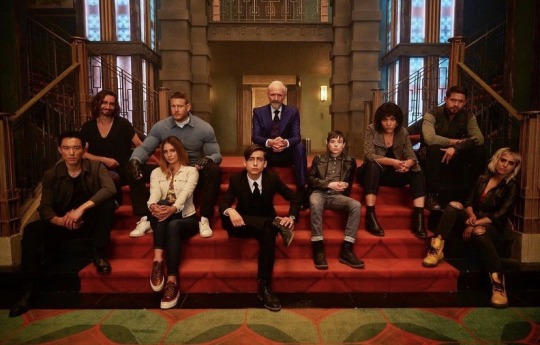
THE CREW
IG credit to steveblackmantv
#tua#tua s3#the umbrella academy#tua fanfic#klaus hargreeves#ben hargreeves#bennerino#mean ben#sparebrella ben#image bank mean ben#image bank klaus#ded & gonne#luther hargreeves#sloane hargreeves#five hargreeves#reginald hargreeves#bad dad#viktor hargreeves#allison hargreeves#mean allison#diego hargreeves#lila hargreeves#hargreeves#location hotel oblivion#location hotel obsidian#image bank hargreeves#image bank group picture#image bank siblings#image bank hargreeves siblings#ded and gonne
318 notes
·
View notes
Text
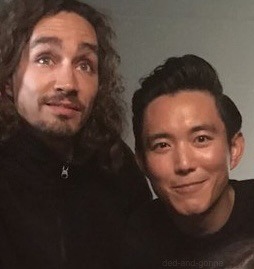
#robert sheehan#justin h min#tua bts#tua#the umbrella academy#klaus hargreeves#ben hargreeves#ded & gonne#tua fanfic#tua s2 bts#tua s2#image bank klaus#image bank ben#image bank ghost ben#image bank long hair klaus#image bank long curly hair#image bank long hair#location past
53 notes
·
View notes
Text

#robert sheehan#klaus hargreeves#justin min#ben hargreeves#tua#the umbrella academy#tua fanfic#tua s3#ded & gonne#robert sheehan character fic#my photo#mine#ded and gonne#we deal in rare books and the dead#image bank hargreeves#image bank siblings#location academy#footloose#footloose klaus and ben#image bank ben#happy ben#laughing ben#dancing ben#loving ben#image bank memories#diego’s acid trip#image bank footloose#location bookstore#location building#justin h min
49 notes
·
View notes
Photo
How Justin is genuinely laughing in the last one.
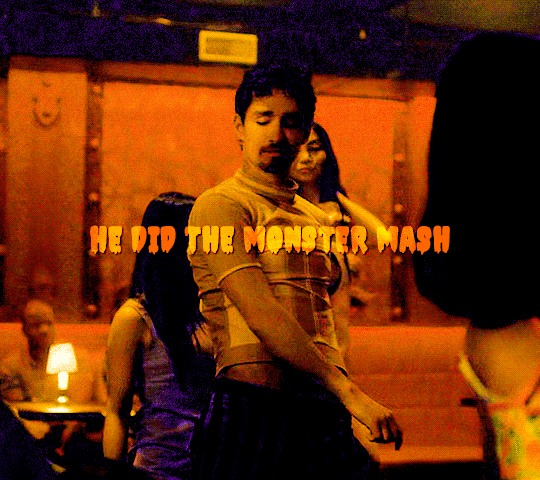
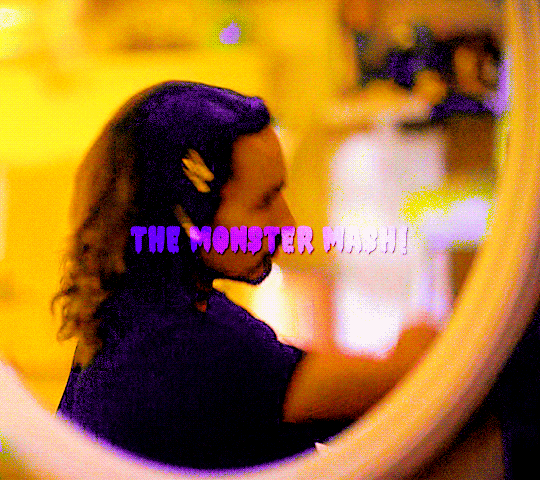
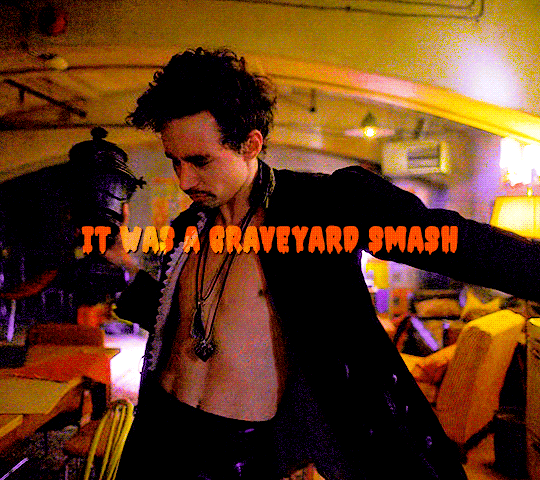
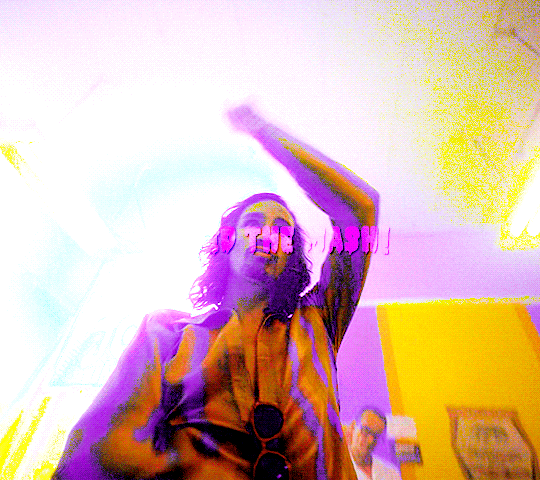
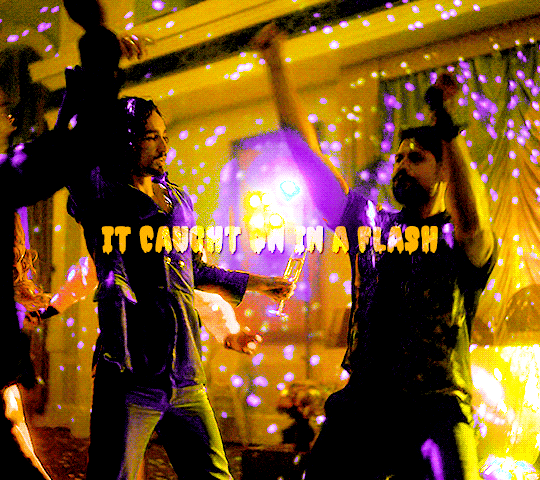
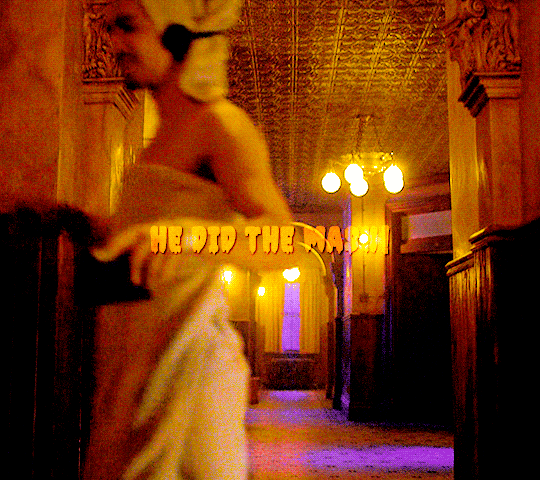
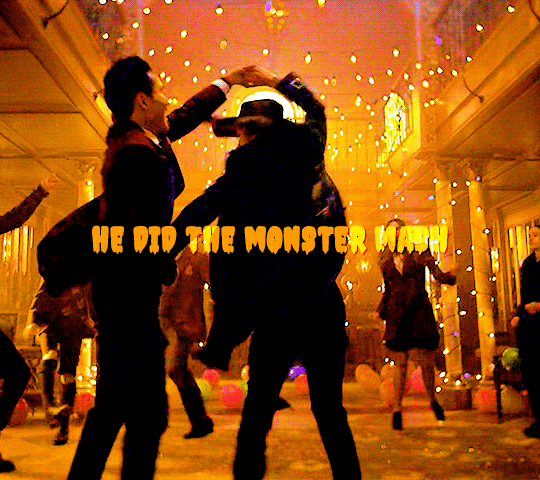
SHEEHALLOWEEN 2022 🔮 Day Five: Free Space
#this is amazing#sheehalloween 2022#klaus hargreeves#tua#the umbrella academy#robert sheehan#justin min#ben hargreeves#sparrow ben hargreeves#justin h min#justin h. min#mean ben hargreeves#evil ben hargreeves#image bank evil ben#image bank ben laughing at klaus#image bank klaus and ben dancing#image bank klaus and ben#location academy#location dream sequence#location footloose#ded & gonne#ded and gonne
575 notes
·
View notes
Text

#tua#the umbrella academy#klaus hargreeves#ben hargreeves#tua fanfic#ded & gonne#image bank hargreeves siblings#image bank hargreeves#image bank the hargreeves#five hargreeves#image bank teen klaus#image bank teen ben#image bank teen five#tua s1#image bank family photo#location crime scene#location steps of bank#image bank bank robbery#costume uniform#costume covered in blood#costume blood#Ded and Gonne#ded and gonne antiquarian booksellers and supernatural detectors#ded and gonne booksellers and private dicks
12 notes
·
View notes
